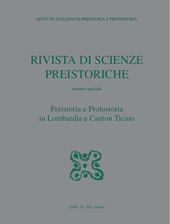Metodi di studio : novità e tradizione nell'arte rupestre della Lombardia e dell'arco alpino
P. 323-341
The study of rock art enjoyed in recent years of a major upgrade as concerns the available tools, especially digital, expressing interesting methodological innovations, in the wake of a tradition for which the documentation of the figurative elements is the key point. Such a study is undertaken in an archaeological sense; the decorated surface is meant as a digging area, the overlaps like a stratigraphic sequence and the iconic finds as archaeological finds. Thanks to its huge heritage of engravings, the Valcamonica-Valtellina rock art complex plays a paradigmatic role for the other areas of the Alps and beyond. In this paper attention is paid to recording methods, in the two lines of the study tradition and of the development of innovative tasks, evaluating the pros and cons for each.
Considering the documentation of the engraved or painted figures as a preliminary to subsequent research steps, aspects relating to photographic documentation, iconographic tracing, cataloging, degradation analysis and photogrammetric and photometric three-dimensional modeling are addressed; some relevant cases in Valcamonica and in the Alps are presented, differentiated as for content (figurative and non-figurative engravings) and engraving-painting technique (pecked or chiseled engravings and rock paintings), including the Great Rock of Naquane, the Ossola rock paintings and some cup-marked rocks of the western Alps.
As for methodological innovations, software and digitization play a leading role: flat and pano spherical stitched photos and chromatic enhancement software for photography, vector restitution and automatic planimetry for tracing, cataloging software, automatic photogrammetry and stereo-photometry for 3D modeling. The pros of photographic documentation include speed, low budget, a good degree of objectivity and ease of communication; on the contrary conditions of bad lighting or worn-out surface produce insufficient results. The iconographic tracing, which in Valcamonica is performed directly on the engraved surface on transparent plastic sheets, has the advantage of being low-cost and of representing an indispensable tool for cataloging, study and publication; its main function, as for an archaeological drawing, is to extract the iconic finds by selecting the relevant elements and making them stand out; among the critical issues, the long completion times.
Photogrammetric 3D modeling is a good tool for the morphological analysis of the engraved or painted rocky surfaces, useful for communication and museum exhibition, but it badly performs as for definition; on the contrary, photometric models allow for a great definition, but cannot cover large surfaces. The conclusions lead us to evaluate how the best choice is to use all the available and practicable methods, trying to integrate them, through virtual tours – performing very well in the combination of zenith or spherical stitched photos, iconographic tracings, 3D models and catalogs of the figures – the implementation of GIS platforms and online databases. [Publisher's text]
-
Articoli dello stesso fascicolo (disponibili singolarmente)
-
Informazioni
Codice DOI: 10.32097/1178
ISSN: 2282-457X


